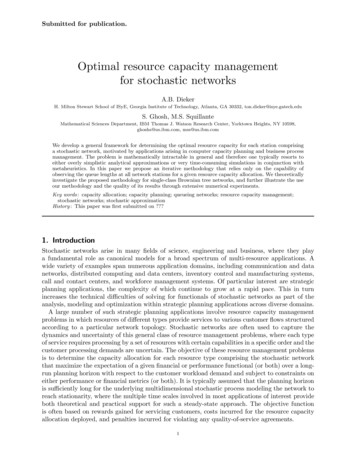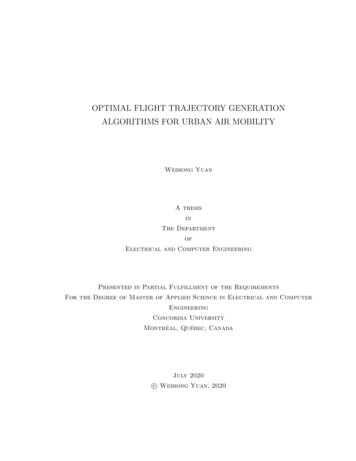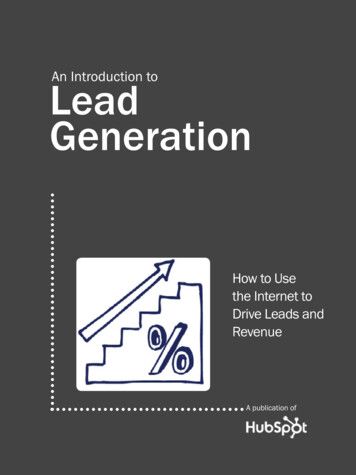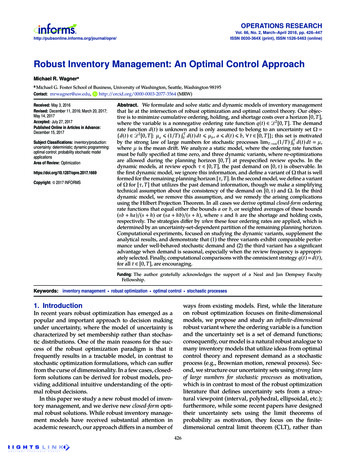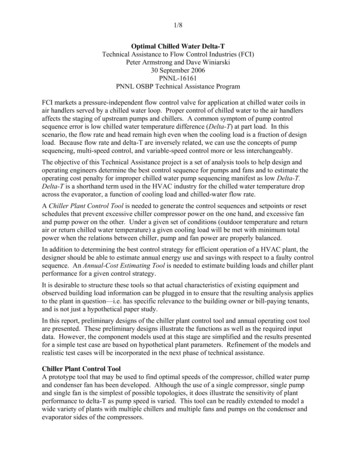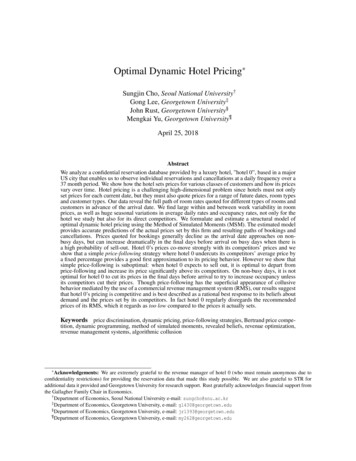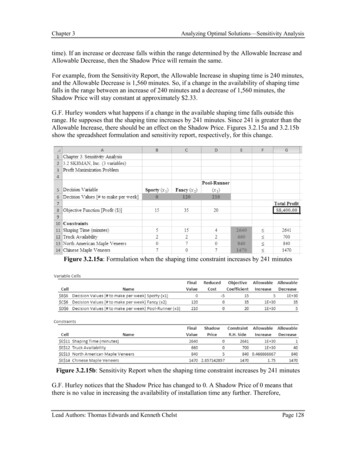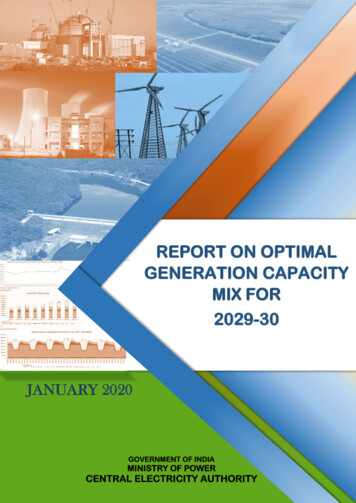
Transcription
REPORT ON OPTIMALGENERATION CAPACITYMIX FOR2029-30JANUARY 2020GOVERNMENT OF INDIAMINISTRY OF POWERCENTRAL ELECTRICITY AUTHORITY
REPORTONOPTIMAL GENERATIONCAPACITY MIX FOR2029-30GOVERNMENT OF INDIAMINISTRY OF POWERCENTRAL ELECTRICITY AUTHORITY
DisclaimerThe study is an exercise to assess the least cost generation capacity mix to meet the projectedElectricity Demand for the year 2029-30. The projected installed capacity shown in the report shouldnot be in any way considered as target of the country. The study is based on numerous assumptions inrespect of technical and financial variables associated with various power generation technologies.Any change in assumptions considered may vary the result.If publication is used, shared, copied, reproduced, printed, appropriate acknowledgement has to begiven to Central Electricity Authority as the source.
Report On Optimal Generation Capacity Mix For 2029-30Executive SummaryThe world today is witnessing several kinds of technological disruptions indifferent sectors. One of the likely disruption in power sector can bereplacement of thermal based generation with Renewable energy generationcomplimented with energy storage technology. This has been possible with thedownward trend of cost of solar panels and newer technology options likebattery energy storage systems. In fact, the reduction in cost projections is veryaggressive for Battery Energy Storage technology to render them financiallyviable in near future. In this context, planning for optimal generation capacitymix gains tremendous importance so as the future generation capacity mix iscost effective as well as environmental friendly, a horizon of 10-12 years issufficient to gear up the systems and policies in the right direction to achievethe optimal generation mix. Keeping this in perspective, the study year of 202930 has been considered.Optimal generation capacity mix is a study primarily aimed at finding out theleast cost optimal generation capacity mix, which may be required to meet theprojected peak electricity demand and electrical energy requirement of the year2029-30 as per 19th Electric Power Survey. The study minimizes the totalsystem cost of generation including the cost of anticipated future investmentswhile fulfilling all the technical/financial constraints associated with variouspower generation technologies.CEA has carried out a mid-term review of National Electricity Plan notified inMarch’18 and assessed the likely installed capacity for the year 2021-22. Theinstalled capacity projected in the midterm review of National Electricity Plan(NEP) has been taken as input to find out the requirement of future generationcapacity mix to be built up by the end of the year 2029-30. The technical andfinancial parameters of different generation technologies have been consideredas per National Electricity Plan. Globally many grid scale energy storagesystems are commercially available or are at nascent stages of development.However, in the studies only commercially available storage technologies likePumped hydro storage systems and battery energy storage systems aremodelled, as the associated technical and cost data was available.The short term studies to assess the economic hourly generation dispatch andadequacy of the capacity mix obtained from long term generation planningstudies for the year 2029-30 have been carried out. All thetechnical/operational characteristics of each individual generating unit havebeen adhered to arrive at the adequacy of the generation capacity mix at leastproduction cost. Due to the technical/operational constraints, the generationfrom RE sources may not be fully absorbed in the system on few days of theCentral Electricity Authorityi
Report On Optimal Generation Capacity Mix For 2029-30year. The report also assesses the impact on RE absorption by reducingpresently stipulated technical minimum load of coal-based plants.Sensitivity analysis for contingency scenarios is carried out by reducingavailable energy from RE sources and hydro power plants to test the systemresilience. Impact on CO2 emissions due to part load efficiency loss of coalbased power plants has also been studied.The study has considered a single demand node for the country and does notconsider any transmission constraint in the year 2029-30.Various stakeholders have submitted their comments on the draft reportpublished on CEA website in July 2019. The comments received on the draftreport by various stakeholders have been incorporated in the final study.Additional scenarios due to uncertainties associated with demand forecast andbattery cost trajectory have also been included in the final study.Central Electricity Authorityii
Report On Optimal Generation Capacity Mix For 2029-30INDEXExecutive Summary . iACRONYMS .v1. Introduction .12. Objective of the Study.23. Why 2029-30? .34. Generation Expansion Planning Tool.46. Generation Capacity mix of the country .57. Present Load Profile of the country .78. Optimal Generation Capacity Mix studies for the year 2029-30 .88.1 Inputs for the Study .88.2 Energy Storage Systems . 138.2.1 Pumped Hydro Storage System. 138.2.2Battery Energy Storage Systems . 148.3 Results of the Study. 148.3.1Long Term studies . 148.3.2Short Term studies - (Hourly Generation dispatch) . 188.3.2.1 Peak Day / Max Energy demand day – 7th October, 2029 . 148.3.2.2 Maximum VRE (Wind Solar) Generation day – 3rd July, 2029. 208.3.2.3 Maximum Solar Generation day – 25th March, 2030. 218.3.2.4 Minimum Solar Generation day – 8th August, 2029 . 228.3.2.5 Minimum Energy Demand Day – 14th December, 2029 . 238.3.2.6 Minimum VRE Generation Day – 1st February, 2030 . 248.3.2.7 Maximum variation in net demand/demand days . 258.3.3 Analysis based on Short-term dispatch for 2029-30 . 288.3.3.1 Daily Variation in Demand and VRE Absorption . 288.3.3.2 Performance Analysis of Thermal Units . 288.4 Study on impact of reducing minimum technical load of coalplants on VRE absorption . 318.5 Impact on CO2 emission due to part load operation of coalbased power plant . 339. International Commitment - INDC Targets . 33Central Electricity Authorityiii
Report On Optimal Generation Capacity Mix For 2029-3010. Projected Achievements of INDCs by 2030 . 3310.1 Installed capacity and share of non-fossil fuel . 3310.2 CO2 emissions from Power Sector by 2030 . 3411. Sensitivity Analysis . 3611.1 10% reduction in Solar and Wind generation during the weekhaving All-India peak demand day i.e. 7th Oct. 3611.2 10% reduction in Solar and Wind generation during the weekhaving minimum solar and wind generation day i.e. 1st Feb . 3711.3 6% reduction in hydro generation during the week having AllIndia peak demand day i.e. 7th Oct . 3811.4 10% reduction in RE generation and 6% reduction hydrogeneration combined together during the week having All-Indiapeak demand day i.e. 7th Oct . 4012. Additional Scenario Analysis . 4212.1 Electricity Demand variation of /- 5% from base case. . 4212.1.1 Increase in Demand by 5% from base case demand. . 4212.1.2 Decrease in Demand by 5% from base case demand. . 4312.2 Increase in the battery cost projections by 2030 to 100/kWh and 125/kWh. . 4312.2.1 Increase in the battery cost projections by 2030 to 100/kWh . 4412.2.2 Increase in the battery cost projections by 2030 to 125/kWh . 4413. Conclusions . .44Annexure-I . 48Central Electricity Authorityiv
REPORT ON OPTIMAL GENERATION CAPACITY MIX FOR 2029-30ACRONYMSACRONYMSEXPANSIONBESSBattery Energy Storage SystemBMSBattery Management SystemBUBillion UnitCAGRCompound Annual Growth RateCERCCentral Electricity Regulatory CommissionCO2Carbon dioxideCUFCapacity Utilization FactorEMSEnergy Management SystemEPSElectric Power SurveyGCFGreen Climate FundGDPGross Domestic ProductGWGiga WattINDCIntended Nationally Determined ContributionKGD6Krishna Godavari Dhirubhai 6kWhkilowatt hourLNGLiquefied Natural GasLWRLight Water ReactorMGRMerry Go RoundMNREMinistry of New and Renewable EnergyMTMillion TonesMUMillion UnitMWMega WattNEPNational Electricity PlanO&MOperation and MaintenancePHWRPressurized Heavy Water ReactorPLFPlant Load FactorPVPhoto VoltaicRERenewable EnergyRLNGRegasified Liquefied Natural GasUNFCCCUnited Nations Framework Convention on ClimateChangeCentral Electricity Authorityv
REPORT ON OPTIMAL GENERATION CAPACITY MIX FOR 2029-30
REPORT ON OPTIMAL GENERATION CAPACITY MIX FOR 2029-301. IntroductionElectricity is one of the key enablers for achieving socio-economicdevelopment of the country. The economic growth leads to growth indemand of power. Generation capacity augmentation is the most vitalcomponent amongst various modes adopted for meeting the ever-increasingdemand of power to achieve the targeted growth rate.After the enactment of Electricity Act, 2003 generation has been delicensedwhich has given impetus to the generation capacity addition and led to hugecoal based generation capacity addition during 11th and 12th plan. India hasmarched ahead in the Power Sector taking huge strides in every sector ofelectricity viz. Generation, Transmission and Distribution. The per capitaelectricity consumption has increased from 592 kWh during 2003-04 to1181 kWh during 2018-19. Consequently, the gap between electricitydemand and supply has reduced drastically in the recent years. Presently,country is having enough generation capacity to meet its electricity demand.The supply gap of peak electricity demand and electrical energy requirementduring the year 2018-19 was only 0.8% and 0.6% respectively. However,huge capacity addition in the recent years has raised concerns related tounder-utilization of the coal based capacities leading to stressed assets inthe sector. The PLF of coal-based plants has reduced to 61.07% during2018-19 from 78.6% during 2007-08. Therefore, there is an increasing needto plan capacity addition optimally in view of the limited availability of fuelresources for generation, new sources of generation and environmentalconcerns.The world is focusing on environmental issues, especially climate changeand therefore the idea of growing sustainably has taken centre stageglobally. In view of this, all countries across the globe have been activelyengaged in climate negotiations on different platforms viz. UNFCCC.Consequently, the world has started moving towards carbon free energy.India being an active participant globally has started taking initiativetowards sustainable development and cleaner environment.Towards realizing the objective of carbon free energy, India has set for itselfa target of installed capacity of 175 GW from Renewable Energy Sources(RE) by March 2022. To further address the environmental issues arisingfrom the obnoxious emissions, more efficient supercritical coal based unitsare being commissioned and old and inefficient coal based capacity is beingretired. Environmental issues along with the reduction in cost of renewableenergy sources (solar PV and wind) have given a push to the solar and windbased power generation technologies. The capital cost of renewable (solarPV and wind) technologies for power generation is becoming competitive dayby day with the coal based generation. These technologies are carbon freeCENTRAL ELECTRICITY AUTHORITY1
REPORT ON OPTIMAL GENERATION CAPACITY MIX FOR 2029-30and will help to achieve the sustainable development programme of thecountry. However, the intermittency associated with the RE technologies isa limitation, which needs to be addressed in the power system. One of theoptions which can help in large scale integration of RE generation sourcescan be adoption of grid scale energy storage technologies which cancomplement RE generation sources. Storage Hydro plants/ Pumped storageplants can be highly useful for facilitating integration of high variable REpower into the power system. While other new storage technologies are innascent stages of development, grid scale battery energy storage systemsare becoming attractive globally due to rapidly reducing cost with thetechnological advancement. The world is anticipating that the grid scaleenergy storage technologies may help to absorb more RE economically intothe power system in the near future.The requirement of the energy storage systems can be fulfilled with anycommercially viable energy storage technology suitable for grid scaleapplications.2. Objective of the StudyTo find out the optimal generation capacity mix to meet the projectedpeak electricity demand and electrical energy requirement in the ptions,intermittency associated with Renewable energy sources andconstraints if any, etc.Optimum generation mix study is an optimization problem for generationexpansion planning, in which the objective function is to minimize:a. The costs associated with operation of the existing and committed(planned and under construction) generating stations.b. The capital cost and operating cost of new generating stations requiredfor meeting peak electricity demand and electrical energy requirementwhile satisfying different constraints in the system such as: Fuel availability constraints. Technical operational constraints viz. minimum technical load ofthermal units, ramp rates, startup and shut down time etc. Financial implications arising out of startup cost, fuel transportationcost etc. Intermittency associated with renewable energy generation.Technologies/Fuel options available for power generation considered in thestudy are: Conventional Sources – Coal and Lignite, Large Hydro includingPumped Storage, Nuclear, Natural gas.CENTRAL ELECTRICITY AUTHORITY2
REPORT ON OPTIMAL GENERATION CAPACITY MIX FOR 2029-30 Renewable Energy Sources- Solar, Wind, Biomass, Small Hydro, etc. New Technologies – Grid scale battery energy storage systems.Note: Various new technologies that may play an important role in powergeneration in future have not been considered in the present study as theyare in nascent stages of development and there is lack of realistic projectionsregarding their financial and technical parameters.3. Why 2029-30?To achieve the target of RE installed capacity of 175 GW by 2022, India hastaken several policy initiatives for encouraging investment in RE Generationsources. National Electricity Plan has also laid its emphasis on REintegration and detailed studies have been carried out in NEP for the year2021-2022 to analyze the power scenario with 175 GW of RE capacity in theGrid. Further, NEP has also given a perspective scenario for 2026-27assuming 100 GW of capacity addition from RE during the period 2022-27in view of the consistency in policy push for RE.India is working towards low carbon emission path while meeting itsdevelopmental goals. In this regard, India is aiming to have 40 % of the totalinstalled capacity by the year 2030 based on non-fossil fuel sources assubmitted in Intended Nationally Determined Contributions (INDCs). This phaseof transition warrants a detailed study of the power scenario in the year2030.Grid scale battery energy storage technologies have started gainingpopularity globally as their cost of installation has been reducing drasticallyover the years. It is anticipated that battery energy storage technologieswould become financially viable and complement RE as a prominentgeneration source in coming years. However, India has a large fleet ofexisting pithead coal power plants, which provide quite cheap electricity. Inview of incoherence between peak demand and RE peak generation, hydroand flexible coal plants can provide the essential support for grid stability.To address the above issues and to optimally utilize the available resourcesthe least cost generation capacity expansion needs to be planned inoptimum manner to meet the forecasted peak electricity demand andelectrical energy requirement of the country in future. Therefore, therearises a need for detailed generation expansion planning studies for powerscenario in 2030 where India can take the carbon-free growth path alongwith optimizing generation from different sources in most cost-effectivemanner. In this context, planning for optimal generation capacity mix gainstremendous importance to ensure future generation capacity mix is costeffective as well as environmental friendly. A horizon of 10-12 years issufficient to gear up the systems and policies in the right direction so as toCENTRAL ELECTRICITY AUTHORITY3
REPORT ON OPTIMAL GENERATION CAPACITY MIX FOR 2029-30achieve the optimally planned generation mix. The study year 2029-30 hasbeen considered keeping this in perspective.4. Generation Expansion Planning ToolThe optimal generation mix study for the year 2029-30 has been carried outusing the state of the art computer Generation Expansion planning modelnamely ORDENA. The model performs generation expansion planning,production costing and has the capability of modelling renewable energysources using Mixed Integer Programming. The model minimises the costof energy generation including the capital investments required for meetingpeak electricity demand and electrical energy requirement by carrying outnumerous iterations for selecting the most optimal generation capacity mixconsidering all financial parameters and satisfying technical/operationalconstraints. It optimizes the cost of transportation of fuel and emissionsfrom power plants. The software has the capability to carry out hourly/subhourly economic generation dispatch considering all the technicalconstraints associated with various generation technologies.The schematic diagram of the software is given as Exhibit 1.Exhibit 1CENTRAL ELECTRICITY AUTHORITY4
REPORT ON OPTIMAL GENERATION CAPACITY MIX FOR 2029-305.Present Installed CapacityTotal Installed Capacity of the country as on 30.09.2019 was 363.4 GW,which comprise of 45.4 GW from H
Report On Optimal Generation Capacity Mix For 2029-30 Central Electricity Authority ii year. The report also assesses the impact on RE absorption by reducing presently stipulated technical minimum load of coal-based plants. Sensitivity anal
